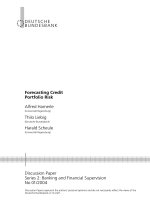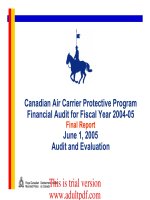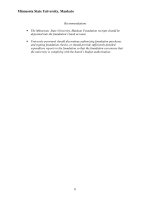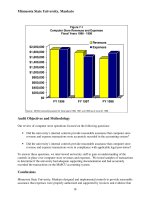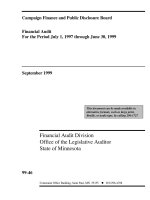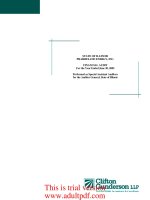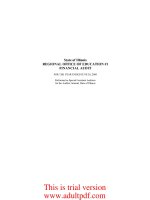Financial information for managemetn paper 1 2 2005 answer 2
Bạn đang xem bản rút gọn của tài liệu. Xem và tải ngay bản đầy đủ của tài liệu tại đây (88.2 KB, 10 trang )
Answers
Part 1 Examination – Paper 1.2
Financial Information for Management
June 2005 Answers
Section A
1
2
3
4
5
6
7
8
9
10
11
12
13
14
15
16
17
18
19
20
21
22
23
24
25
C
C
A
C
B
B
B
A
D
D
A
A
B
C
B
C
A
B
C
B
D
B
A
A
A
1
C
2
C
3
A
T1
T2
T3
T4
Cost
Total cost per unit (£)
Total cost per unit (£)
(125 units)
(180 units)
8·00
7·00
14·00
14·00
19·80
15·70
25·80
25·80
types T2 and T4 are variable and T1 and T3 are semi-variable.
4
C
Contribution per unit (CPU) = (80 – 30 – 10) = £40
Total fixed cost = 2,880 × 25 = £72,000
Break-even point = 72,000 ÷ 40 = 1,800 units
5
B
CPU = 0·40 × 60 = £24
Break-even point = 54,000 ÷ 24 = 2,250 units
Margin of safety = 4,000 – 2,250 = 1,750 units
6
B
Σx = Σ Advertising expenditure = 100,000
Σy = Σ Sales = 600,000
n = number of pairs of data = 5
7
B
8
A
9
D
17
10 D
Total hours in cost centre X = 8,000 × (3 + 2·5) = 44,000
Total hours in cost centre Y = 8,000 × (1 + 2) = 24,000
Overhead rate (X) = £88,000 ÷ 44,000 = £2 per hour
Overhead rate (Y) = £96,000 ÷ 24,000 = £4 per hour
Overhead cost per unit (P2) = (2·5 × 2) + (2·0 × 4) = £13
11 A
Actual overheads
Absorbed overhead (8,800 × 14·50)
Under absorption
£
128,480
127,600
880
12 A
13 B
Date
1st
3rd
12th
17th
19th
Units
300
500
(600)
——–
200
400
(300)
——–
300
——–
£ per unit
9
11
£
2,700
5,500
(6,400)
———
1,800
4,200
(3,150)
———
2,850
———
9
10·5
10·5
14 C
£
700
1,300
———
2,000
840
———
2,840
———
Prime cost (300 + 400)
Production overheads (50 × £26)
Total production cost
Non-production overheads (1·20 × 700)
Total cost
15 B
[5,500 + 900]
(150 × 0·48) equivalent units × £12 = £864
16 C
Units started and finished last month (900 – 100) = 800 × £12
Opening work in progress (WIP) value
Work done to complete opening WIP (100 × 0·40) × £12
17 A
Price variance:
Actual sales revenue
Actual sales units at standard selling price (10,500 × £20)
Sales price variance
Volume variance (500 units × £20 × 0·40)
£
9,600
680
480
———
10,760
———
£
204,750
210,000
————
5,250
———
4,000
18 B
Capacity variance (5,000 – 5,500) hours at £15 per hour
19 C
250 hours at [£9 per hour + the opportunity cost £(12 ÷ 3) per hour] = £3,250
The incremental labour cost of weekend working is £4,500 (250 × £18) and
being higher than £3,250 is therefore not relevant.
20 B
Opportunity cost now
Realisable value in six months
Relevant cost
21 D
Additional cost of buying in (compared with manufacture) per hour:
A
B
C
D
£10
£8
£12
£7
Buy in component with the lowest additional cost per hour (limiting factor).
£8,000
£5,000
£3,000
18
7,500
A
F
F
22 B
Branch Z makes a net contribution (after specific branch fixed costs of £10,000) of £10,000.
Closing branch Z will leave a revised profit of £20,000 for the company.
23 A
24 A
1,000 kg of material G produces 100 units of product Y = 10 kg per unit
1,800 kg of material H produces 90 units of product Y = 20 kg per unit
25 A
Total contribution from:
£
A 90 units of Y (90 × £20)
1,800
B 50 units of X + 60 units of Y (50 × 8) + (60 × 20) 1,600
C 60 units of X + 50 units of Y (60 × 8) + (50 × 20) 1,480
D 125 units of X (125 × 8)
1,000
Optimal mix is the one giving the highest total contribution (£1,800)
Section B
1
(a)
Process Account
Kg
10,000
Raw materials input
Direct labour
Overheads (140% of
direct labour)
Abnormal gain (W3)
100
–––––––
10,100
–––––––
£
18,750
50,000
70,000
Joint products (W1):
Product X
Product Y
1,450
––––––––
140,200
––––––––
Cost per kg
Costs arising (18,750 + 50,000 + 70,000)
Less: Normal loss (realisable value)
Normal loss (W2)
Kg
£
5,600
4,000
———
9,600
67,200
72,000
————
139,200
500
–––––––
10,100
–––––––
1,000
––––––––
140,200
––––––––
£
138,750
(1,000)
————
137,750
————
Cost per kg:
£137,750 ÷ (Normal yield from 10,000 kg)
= £137,750 ÷ (0·95 × 10,000) = £14·50
Workings:
W1
Product
X
Y
Selling price
£/kg
25·00
37·50
Production
(ratio 7:5)
kg
5,600
4,000
Sales value of
production
£
140,000
150,000
Total joint production cost (X + Y) = 9,600 kg at £14·50 = £139,200
Apportioned A : B in the ratio 140,000:150,000 (= 14:15)
Product X = £67,200 and Product Y = £72,000
(b)
W2
5% of 10,000 = 500 kg at £2 per kg = £1,000
W3
(500 – 400) = 100 kg at £14·50 per kg = £1,450
A by-product is an output from a process that occurs incidentally to the main production and is insignificant in value terms.
The inputs to a process are intended to create the main product or products but sometimes quite incidentally a by-product is
also created, which has a relatively low value compared to the main products.
19
2
(a)
£
Standard cost of actual production
9,000 units × £(15 + 20 + 12)
Total variances:
Direct materials (W1)
Direct labour (W2)
Fixed overheads (W3)
£
423,000
3,000 A
2,000 F
5,000 F
————
Actual cost
Workings:
W1
Actual
£
138,000
Standard cost of actual production (9,000 × £15)
135,000
W2
Actual
178,000
Standard cost of actual production (9,000 × £20)
180,000
W3
Actual
103,000
Standard cost of actual production (9,000 × £20)
108,000
Actual quantity × actual cost
138,000
4,000 F
————
419,000
————
Variance (£)
3,000 A
2,000 F
5,000 F
(b)
Price
6,000 F
Actual quantity × standard cost
(24,000 × £6)
144,000
Usage
9,000 A
Standard quantity for actual production
X standard cost [(as in (a)]
(c)
3
135,000
(i)
The standard price per litre is set by the person in the organisation with the specialist knowledge about the prices
charged by suppliers for the raw materials used by Murgatroyd Ltd. This would be the manager responsible for
purchasing (sometimes referred to as the Buying Manager or the Procurement Manager).
(ii)
The standard quantity per unit is set by the person in the organisation with the specialist knowledge about the product
specification and the amount of each raw material that should be used in the manufacture of one unit of the product.
This would be a manager in the production (manufacturing) function or technical department in Murgatroyd Ltd.
(a)
EOQ = [(2 × 12·50 × 8,760) ÷ (0·05 × 80)]0·5 = 234 units
(b)
Usage per day = 8,760 ÷ 365 = 24
Re-order level = 24 × 21 = 504 units
(c)
(i)
A stockout occurs when a company runs out of stock. There are costs associated with this – lost contribution from lost
sales, for example. In order to avoid a stockout the company could set a buffer stock – in effect a safety level of stock
to cover emergency situations such as demand and/or lead times exceeding their average levels. The holding of a buffer
stock involves an additional cost.
(ii)
Jane plc should consider having a buffer stock if either the usage of component RB starts to fluctuate from period to
period (at present it is constant) and/or the lead time starts to fluctuate from its present constant level of 21 days.
20
4
(a)
(i)
Units
Higher level
Lower level
Difference
2,000
1,800
———
200
———
Total cost
£
188,000
180,000
————
8,000
————
Variable production cost per unit = 8,000 ÷ 200 = £40
(ii)
£
188,000
(80,000)
————
108,000
————
Total production cost for 2,000 units
Less total variable production cost (2,000 × 40)
Total monthly fixed production cost
(b)
(i)
Contribution per unit (180 – 40) = £140
Total contribution from sales = 1,200 × 140 = £168,000
(ii)
£
168,000
(149,000)
————
19,000
————
Total contribution [as in (b)(i)]
Less Total fixed costs (108,000 + 41,000)
Net profit
5
(c)
When the number of units produced and the number of units sold in a month are identical, the net profit or loss determined
by using absorption and marginal costing principles will also be the same. In other words the net profit or loss will be the
same when the opening and closing stocks for a month are unchanged.
(a)
(i)
Initial selling price = (variable + fixed cost per unit) + mark up of 40%
Initial selling price = [£4 + £(18,000 ÷ 3,000)] × 1·40 = £14
(ii)
Profit = 3,000 units × £4 profit per unit = £12,000
(b)
Profits are maximised when:
Marginal cost (MC) = Marginal revenue (MR)
MC = variable cost = 4
MR = 20 – 0·004Q
4 = 20 – 0·004Q
Q = 4,000 units
P = 20 – 0·002 (4,000) = £12 = profit maximising price.
(c)
A penetration price is an initially low selling price of a product, whereas a skimming price policy is one where the initial selling
price is set high.
21
Part 1 Examination – Paper 1.2
Financial Information for Management
June 2005 Marking Scheme
Marks
Section A
Each of the 25 questions in this section is worth 2 marks
50
–––
Section B
1
(a) Inputs into process
Normal loss
Abnormal gain
Joint products
11/2
11/2
2
3
–––
8
(b)
Incidental to main products
Insignificant in value terms
1
1
–––
2
–––
10
–––
2
(a)
Each total variance 1 mark
Reconciliation statement
3
1
–––
4
(b)
11/2
11/2
–––
Price variance
Usage variance
3
(c)
11/2
11/2
–––
Purchasing management
Production management
3
–––
10
–––
3
(a)
EOQ calculation
2
(b)
Stock level for re-ordering
2
(c)
(i)
Stockout
Buffer stock
(ii)
Variable demand and fluctuating lead time
1
1
2
–––
4
–––
8
–––
4
(a)
(i)
Variable production cost per unit
(ii)
Total monthly fixed production cost
2
2
–––
4
(b)
(i)
Total contribution
(ii)
Net profit
2
2
–––
4
(c)
Production = sales and/or opening stock = closing stock
23
2
–––
10
–––
Marks
5
(a)
(i)
Initial selling price
(ii)
Resultant weekly profit
2
1
–––
3
(b)
Marginal cost (MC) = Marginal revenue (MR)
MC
Optimal quantity (via MC = MR)
Optimal price
1
1
3
2
–––
7
(c)
Penetration price
Skimming price
1
1
–––
2
–––
12
–––
24
